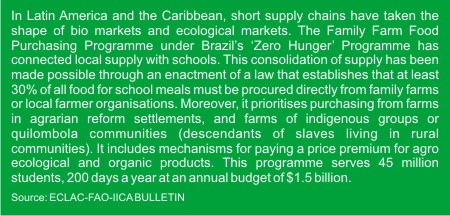|
Revamping the Indian Agricultural System
The
Indian agricultural system having a ‘productionist’ approach, is highly
resource intensive and has not invested much in the quality and
management of natural resources. Neither has it translated to higher
incomes for small holder farmers which could have reduced the need to
migrate. The natural resources such as land, water, energy etc. are
becoming limited.
In India, government is spending 30 percent of its total subsidy on food, fuel and fertilisers. The fertiliser subsidy alone amounted to Rs 70,000 crore in 2017-18 (Bureau, 2018). In some states, there is input assistance scheme in which state governments pay a certain amount of money to the farmers to enable them to recover the cost of agri-inputs, whereas, there are no incentives and policies which makes agriculture risk free with respect to the environment. This dis incentivises the farmers to opt for sustainable and healthier production systems. Income and socio-economic status are found to be the major determining factors of nutritious food consumption patterns in India. The food consumption pattern of Indian households is strikingly different in urban and rural landscapes. The richest 5 percent of urban India spends Rs 2,859 per head per month on food which is nine times more than that spent by the bottom 5 percent of rural India (NSSO survey, 2011-12). What Can Policy Makers Do? Strengthen local production systems that would shorten the value chain and incentivise local producers This can be achieved by promoting diversified farming, shifting away from the traditional monoculture patterns which would also require a change in procurement policies. Strengthening localised production and consumption systems will not only lower the middle men interference but also lower environmental impact in logistics and ultimately help small producers capture greater value and ensure stable incomes. Investing in agri-enterprises that brings affordable and nutritious food to the deprived households
In order to capture the value within the local production systems and
food chains to be more environmentally sustainable offering quality
food, investing in more agri-enterprises in the rural regions is the
need of the hour. This will help in creating more jobs and enhance
resilience of farming communities.
Food policy at the national level to set a long-term vision on health, nutrition, environment, social and economic goals The government should look at the ‘Integrated health and environment approach to food systems’ and realise the connected nature of food systems. This will generate greater value to the producers while ensuring better quality of food to the consumers. Nutritional security for the poor will require a change in the procurement policies that would take agro ecology, fairness and traceability into consideration. Also, mechanisms need to be developed for incentivising farmers who consider environment sustainability. ■
Satabdi Mohapatra
References:
|
